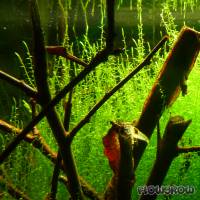



Drepanocladus aduncus is an aquatic moss also found in bogs that is distributed in almost all the world and quite commonly found in Central Europe. It mainly grows on the edges of ponds, on riverbanks and lakeshores, in wetlands and fens. It often forms semi-emersed dark green cushions in shallow water. Its sickle-like, curved shoots reach above the waterline. Its submersed shoots have an upright growth habit, and under a lot of light and when growing close to the surface, they ramify readily. In deeper water or under less light the shoots are less ramified, the foliage is not as dense. Under these conditions, this moss is not distinguishable from "Stringy Moss". In our opinion the "Stringy moss" does not belong to Leptodictyum riparium but to Drepanocladus aduncus.
D. aduncus is difficult to discern from other species of the genus Drepanocladus like D. polygamus, however, it is more frequently found in nature than the latter. It also resembles bogmosses and aquatic mosses of related genera like Scorpidium, Calliergon, Warnstorfia, Leptodictyum and Amblystegium.
The moss sold in trade under the name "Drepanocladus spec. aduncus" or "Aduncus Moss" apparently does not belong to Drepanocladus aduncus at all; it resembles some forms of Leptodictyum riparium native to Central Europe.
The moss Calliergonella cuspidata is very widely spread and can occur in the same places as Drepanocladus aduncus. It differs from the latter by its lighter green hue, straight (not curved) prickly shoot tips and a missing or short double midrib (D. aduncus has a distinct midrib reaching above the middle of the leaf but not to the leaftip).
In the aquarium, D. aduncus can be used in the same way as "Stringy Moss" due to its upright growth, however, it looks more robust and more ramified. Its slightly sickle-like curved leaves and shoots distinguish it further. However, it is as undemanding, and it is a very suitable moss for cold- and warmwater tanks and especially for low-tech tanks with native plants. For a moss, it is a fast grower. Under good conditions it can even become a weed. Drepanocladus aduncus can be bound to rocks or driftwood e.g. with fishing line, or it can be held down on the ground. However, it will not attach to the underground by itself. Under strong lighting and with an ample supply of CO2 it will form a very large number of oxygen bubbles. If it is not attached well it will thus start floating. If allowed to grow to the surface it will form a dense mat with the shoot tips growing above the waterline.
Stringy moss is also a beautiful moss to keep in high, narrow glass vases or similar glass vessels.
D. aduncus also establishes well on the edge of garden ponds, especially if they have a planted boggy shallow-water zone.
<a href="https://www.flowgrow.de/db/aquaticplants/drepanocladus-aduncus" target="_blank"><img alt="Drepanocladus aduncus" title="Drepanocladus aduncus" src="https://www.flowgrow.de/db/widget/aquaticplants/drepanocladus-aduncus" /></a>
[url=https://www.flowgrow.de/db/aquaticplants/drepanocladus-aduncus][img]https://www.flowgrow.de/db/widget/aquaticplants/drepanocladus-aduncus[/img][/url]
[widget=aquaticplants/drepanocladus-aduncus]Drepanocladus aduncus[/widget]